2010 Sea-Doo GTX 155 Review
Familiar name, all-new appeal
Sea-Doo’s got a lot going on in its lineup, which is good and bad. Good, of course, is that the company has continued to innovate and break the mold, especially during tough economic times. Bad, however, is that with so much going on at the top of the lineup, some really great middle-range boats get overlooked.
Like the GTX 155…
Trickle Me
A lot actually happened to this iconic Sea-Doo model in 2010. Yes, the name may remain the same, but apart from the engine, much has changed.
The GTX 155 was one of a number of boats to benefit from all that Sea-Doo techno-wizardry of the past year. That means for 2010 it gets an all-new hull (the same one that debuted on the high-end suspension models last year), a new top deck (very similar in style to the suspension models), and lots of iControl technology, like Intelligent Brake and Reverse as well as Intelligent Throttle Control.
Let’s start with the hull and deck. From a distance, the GTX 155 closely resembles the “two-part” suspended design introduced last year. Sea-Doo wisely used the basic form, but left off the suspension, shaving thousands off the price tag as well as significant pounds off the boat’s weight. It’s significantly longer than the previous GTX hull (about nine inches total), and just feels bigger all around. That makes this boat a worthy competitor to other “big-wave” models like the Kawasaki Ultras or Yamaha FX models. As opposed to being tossed around by choppy conditions, it motors on through with authority. It’s also made of a new lighter-weight material, and the hull features an internal ribbing to increase strength. There’s even a step in the running surface, a speedboat trick aimed to reduce drag.
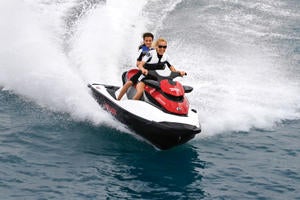 The new hull allows the rider to carve a more aggressive line than the previous version.
The new hull allows the rider to carve a more aggressive line than the previous version.With a little time, I’ve found it to be a more-than-worthy replacement to the old GTX hull, as it handles a wider variety of water conditions better, and will also carve a more aggressive line than its predecessor.
Up top, however, the new design has one big disadvantage — storage. Previous GTX models had decent capacity, but the new styling has reduced the storage total to a paltry 14 gallons, meaning these models are now on the low end of the spectrum. That makes a big difference if you’re planning on extended touring, or just like to bring a lot of stuff along for the ride. The majority of that space resides in Sea-Doo’s now-familiar lift-out tub. I find it great for really keeping things dry, but it is harder to access out on the water. Engine access, however, is very convenient. A one-piece seat replaces the split sections of past GTX models, and lifts on a pneumatic strut. That eliminates the worry of where to put the seat when you’re trying to do simple maintenance.
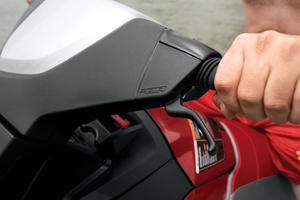
As mentioned, this model gets much of the iControl technology for 2010. That means the boat starts essentially in neutral; the computer carefully controls the reverse/brake bucket to keep the boat as close to stationary as possible. Going forward simply requires squeezing the throttle. Stopping that motion, or going into reverse, requires similar input on the lever on the opposite grip. Eyes stay on the water, hands stay on the bars, and the boat stays in control. It all adds up to the easiest and most intuitive maneuvering I’ve ever experienced on a PWC around a crowded dock or launch ramp.
Of course, that reverse lever is also a much-heralded brake. Squeeze it underway and the bucket drops to rapidly arrest forward motion (near a 50-percent improvement over a standard model in terms of stopping distance), while the computer keeps stopping motion from being so abrupt as to toss you over the handlebars. Learn to feather the brake, like you would in a car, and the result is a rapid, but controlled deceleration.
Competitors have attacked the brake as of late for giving riders a false sense of security; in many close-quarters, collision-avoidance situations, the normal off-throttle steering will likely produce a better result. But I’d argue that a lot of stopping situations aren’t panicked, but just unexpected. In that regard, the braking will likely change the way experienced owners ride, as well as give beginners, who tend to panic and simply clench the bars, a level of safety not previously experienced.
Give Me More
Along with the braking system comes Intelligent Throttle Control, an electronic, rather than physical cable link between throttle lever and engine.
Essentially, it enables speed control. Riders can select a cruising speed, and then have the craft keep the pace with the push of a button. The same can be done for towing duties, to provide a steadier digital hand on the throttle and keep the driver’s attention focused forward. Should a rider fall, the control “remembers” your last speed and accelerates back to it once you’re up and running again. Adjustments can be made on the fly to bump speed up or down. There’s also a setting for no-wake zones, which allows the driver to release the throttle during those lengthy slow-speed areas.
Sea-Doo further tweaked the throttle control software in 2010 to give engines two unique acceleration curves. The 155, like all similarly equipped models, now starts in a gentler “touring” mode, which is less aggressive for families or newcomers, or those who simply want a tamer ride. Opt out and you can enter “sport” mode, which features a more aggressive acceleration curve. The boat will now hit harder of the bottom, and accelerate more strongly through the midrange, en route to the same top speed.
You’ll also find electronic trim adjustment, a display which includes fuel-consumption readouts as well as an electronic compass, along with non-techy goodies like tilt steering and a flip-down boarding step.
Go-Go
All in all, the GTX 155 sounds like — and in my opinion, is — a great boat. So why do I think it’s in danger of being overlooked?
Much of the reason lies in that number at the end of its name. In today’s age of big horsepower, a 155 seems almost puny by comparison. This is the same 1,494cc Rotax engine used throughout the line, but lacking a supercharger — meaning it’s less powerful. Acceleration isn’t the arm-stretching feel you’ll find on the top models, and top speed is limited to around 57 mph.
Whether that’s a deal-breaker depends on your needs. I’d argue that the slightly tamer power is more than enough for most enthusiasts. Remember, not that many years ago this was the top of Sea-Doo’s line. It’s also more fuel-efficient, and runs on 87-octane fuel. Add in the abundance of iControl tech and a great new hull, and it all adds up to an experienced platform with a new spring in its step.
In short, smart buyers would be wise to stop and take a look.
| Sea-Doo GTX 155 Specs | |
| Length | 139 inches |
| Beam | 48 inches |
| Dry Weight | 825 lbs |
| Engine | Naturally aspirated three-cylinder |
| Displacement | 1,494 cc |
| Bore and Stroke | 100mm x 63.4mm |
| Compression Ratio | 10.6:1 |
| Rated Horsepower | 155 |
| Fuel Capacity | 15.9 gal. |
| Combined Stowage Capacity | 13.7 gal. |
| Color | Autumn Red |
| Price | $11,599 |
Related Reading
2010 Sea-Doo GTX Limited iS 260 Review
2010 Sea-Doo GTI 130 Review
2010 Sea-Doo Lineup Preview
All Things Sea-Doo on PersonalWatercraft.com
Get PersonalWatercraft.com in your Inbox!
Like PersonalWatercraft.com on Facebook
Comments
Most Popular

2025 Yamaha JetBlaster PRO 2-Up Review

2024 Kawasaki Jet Ski STX 160X Review

Remembering the Sea-Doo XP

Whatever Happened to the Wetbike?

2025 Yamaha JetBlaster Review




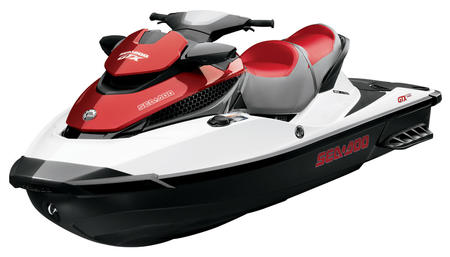
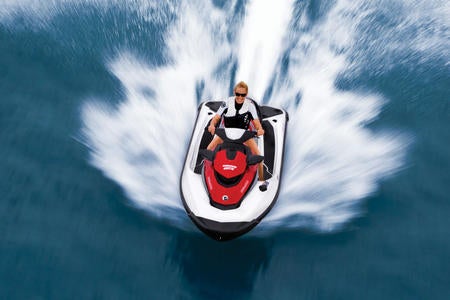
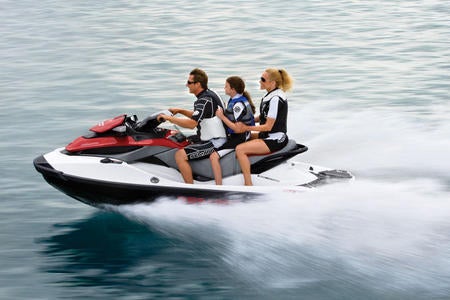
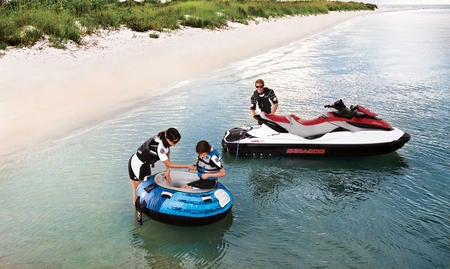







 Your Privacy Choices
Your Privacy Choices